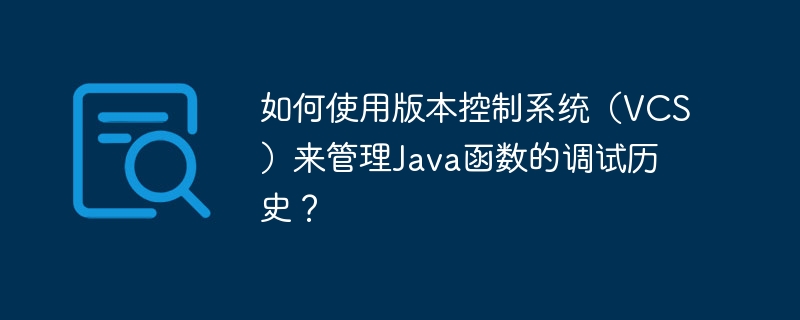Home >Java >javaTutorial >How to use a version control system (VCS) to manage the debugging history of Java functions?
How to use a version control system (VCS) to manage the debugging history of Java functions?
- 王林Original
- 2024-04-24 16:06:02620browse
Using a version control system (VCS) to manage the debugging history of Java functions involves the following steps: Selecting a VCS (such as Git) Initializing the VCS (git init) Adding files to the VCS (git add) Submitting changes (git commit) When debugging errors Commit changes (git add, git commit) View old versions (git log) Roll back to earlier versions (git reset) Use branches to make independent changes (git checkout, git merge)

How to use a version control system (VCS) to manage the debugging history of Java functions
Use a version control system (VCS) to manage code changes, track bug fixes, and roll back when needed It's critical to get to an earlier version. In this article, we will explore how to use VCS to manage the debugging history of Java functions.
Choose a VCS
There are many VCSs to choose from, such as Git, Mercurial, and Subversion. For small projects, Git is a great choice because it's simple to use and distributed, meaning every developer has a complete copy of the code.
Install VCS
Install VCS on your computer. See the VCS documentation for detailed instructions.
Initialize VCS
In the directory containing the Java function, use the following command to initialize VCS:
git init
Add file
Add the Java function files to be versioned to VCS:
git add <function_file_name>.java
Submit changes
Use the following command to submit the added files to the warehouse:
git commit -m "Initial commit of Java function"
Debug Errors
When debugging a Java function, some code changes may be made. Use VCS to record these changes:
git add <function_file_name>.java git commit -m "Fixed bug in Java function"
View old version
Use the following command to view an earlier version of the Java function:
git log
Rollback To an earlier version
If necessary, you can roll back to an earlier version of a Java function using the following command:
git reset --hard <commit_hash>
Using a branch
branch Allows independent changes to Java functions without affecting the main branch. Create a branch:
git checkout -b <branch_name>
After making changes on the branch, merge it to the master branch:
git checkout master git merge <branch_name>
Practical case
Let’s create a Java Function to calculate the sum of two numbers:
public int add(int a, int b) {
return a + b;
}Now, let’s simulate a debugging scenario and fix a bug.
-
Use the following command to add the file to VCS and commit the initial version:
git add Add.java git commit -m "Initial commit of Java function"
-
To simulate the error, let us deliberately introduce a wrong calculation:
public int add(int a, int b) { return a - b; } -
Submit the wrong version:
git add Add.java git commit -m "Incorrectly implemented addition"
-
Debug the error and fix it:
public int add(int a, int b) { return a + b; } -
Submit a fix:
git add Add.java git commit -m "Fixed addition error"
- When a problem occurs, we can use
git logto view the history of the Java function and roll back to an earlier version.
Conclusion
Using VCS to manage the debugging history of Java functions is crucial as it allows tracking code changes, fixing errors and rolling back to earlier versions. This article provides a comprehensive guide to using VCS, including practical examples.
The above is the detailed content of How to use a version control system (VCS) to manage the debugging history of Java functions?. For more information, please follow other related articles on the PHP Chinese website!

